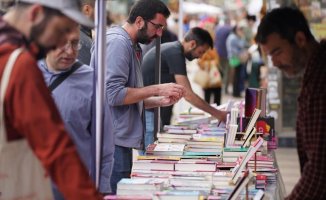Herodotus estimated that the construction of the great pyramid of Cheops, the tallest in the world, had taken twenty years of work. It was probably almost three decades. The new Gallery of the Royal Collections, if it is inaugurated as intended by the current president of National Heritage, Ana de la Cueva, next summer, it will have been 25 years since the idea arose in the time of José María Aznar. The project undoubtedly also had something pharaonic in it – the building, located next to the Royal Palace and the Almudena, has seven floors and 40,000 square meters and is finished but empty... since 2015! – and the result, after multiple vicissitudes and ups and downs, including at some point an unsuccessful battle with the Prado Museum -in which National Heritage has deposited great paintings such as Bosco's Garden of Earthly Delights or Van der Weyden's Descent from the Cross-, the year can finally be assessed next.
Then it will be clear whether or not it was necessary to create a new museum to show the best of the 160,000 pieces that the royal collections treasure, if there really was a mine of treasures buried in the warehouses that had to be shown to the public, as its promoter, Álvaro, assured Fernández-Villaverde, Duke of San Carlos, appointed president of National Heritage by Aznar, or, as another of his successors said, José Rodríguez-Spiteri, who ended up throwing in the towel in 2015 in his unsuccessful battle to recover the Prado paintings, “ I wish there was something good in the warehouses that we could turn into an icon, we ruled out discovering strange treasures in the warehouses, because the good is already exposed”. A long succession of rich tapestries and carriages did not strike him as the most attractive marketing.
If it had to be called the Royal Collections Museum, the team that Ana de la Cueva has chaired for a year has preferred to choose a more open concept, Royal Collections Gallery, to name the rationalist and impressive building by Tuñón and Mansilla – who died in 2012, before the colossus was completed–, which has won 14 awards, including the FAD for Architecture, and despite the fact that there was no rush to open it, it cost 140 million euros. That yes, incredibly 20 less than budgeted, but very far from the 60 in which the then vice president Francisco Álvarez-Cascos estimated it in 1998 when announcing the idea of a new museum. A museum that in fact, as an example of the vicissitudes that the project has experienced, initially had to have been built by the architects Cano Lasso, but the initial competition was contested and annulled.
Now the opening will take place initially in the summer of 2023 with 650 works on the three long exhibition floors, three diaphanous naves 103 meters long by 16 meters wide. After infinite delays –the works were delayed due to the ruins found, which will now form part of the exhibition discourse, but once the center was completed, it was announced for 2016, 2017, 2018... while waiting for the costly museography to be put out to tender– and after changes in discourse that more or less extolled the monarchy in the history of Spain, the museum will open with works ranging from the 15th to the 20th century – with the exception of the Visigoth Treasure of Guarrazar, from the 7th century – following the collections and their origins chronologically since the Kings Catholics. And since marketing is obviously necessary, in addition to remembering its incredible collection of tapestries – some 3,000, perhaps the best collection in Europe – and that of the impressive Royal Armory, they underline that paintings by the great masters will also be exhibited, from Hieronymus Bosch to Velázquez or Caravaggio, Goya, Tiépolo and Mengs, in addition to a deposit that the Prado Museum will make and that they still do not want to reveal.
The ten pieces with which they want to attract the interest of the public for being, they emphasize, unique, are the powerful and solitary White Horse by Velázquez, the Salomé with the head of the Baptist by Caravaggio, the Polyptych of Isabel the Catholic by Juan de Flandes, the tapestry El columpio by Goya, El arcángel san Miguel vanquishing the demon, a Baroque polychrome carving by Luisa Roldán, La Roldana, from 1692, which catapulted her career by making her a chamber sculptor for Carlos II, an Aztec miter of tropical bird feathers from the 16th century XVI with scenes of the Passion of Christ and his resurrection, the first edition of Don Quixote, the armor and helmet of Carlos V in the battle of Mühlberg, a chest of drawers of Carlos III by Gasparini, Canops and Vendetti and a luxurious black carriage that belonged to Queen Mariana of Austria.
A third of the pieces will be exhibited on a rotating basis in the exhibition and will later return to the different National Heritage palaces and monasteries, from El Escorial to La Almudaina in Mallorca or La Granja in Segovia, to which they belong, thus trying to dispel concerns of decapitalization that it caused in the populations in which the rest of the palaces and monasteries of the institution are located, previous more centralist proposals. Concerns that have even reached the municipal plenary of towns such as San Lorenzo del Escorial.
Now begins the one-year countdown to finally materialize the opening of a center that someone came to baptize as "the museum that nobody wanted to open" and that the combination of a 21st century building and historical collections demonstrates that the project that it has dragged on for 25 years, but that it had already had some antecedent even during the Second Republic, showing that it was necessary and that a megaproject was needed that would value treasures that barely saw the light of day.













